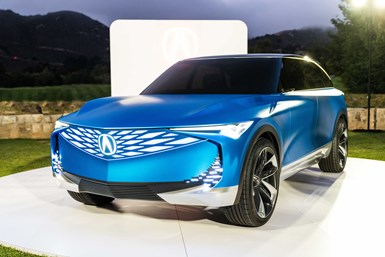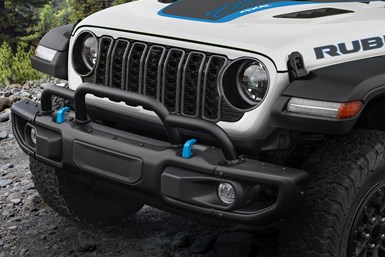
The Tesla Model 3 in its base color: Pearl White Multi-Coat. Musk’s plan is to reduce carbon emissions — an effort that can be described as “green” — yet there is no green paint option for any of the Tesla models. Photo Credit: Tesla
The rationale behind the existence of Tesla can be discerned in the “Master Plan” that Elon Musk published in 2006, which says, in part: “the overarching purpose of Tesla Motors (and the reason I am funding the company) is to help expedite the move from a mine-and-burn hydrocarbon economy towards a solar electric economy, which I believe to be the primary, but not exclusive, sustainable solution.
“Critical to making that happen is an electric car without compromises, which is why the Tesla Roadster is designed to beat a gasoline sports car like a Porsche or Ferrari in a head to head showdown.”
Musk’s focus was on sustainability, something that is encompassed by the category “environmental.”
And from the point of view of color, “environmental” is associated with green, as it is generally thought of in the context of trees and grass and the like.
But were you to go online to order a Tesla Model Y you’d discover that the standard (i.e., no up-charge) color is Pearl White Multi-Coat.
There are four optional colors. None are green.
Model 3? Ditto.
(The optional colors, in case you’re wondering, are Midnight Silver Metallic, Deep Blue Metallic, Solid Black and Red Multi-Coat.)
So here is the OEM that is most widely associated with electric vehicles, vehicles that are, comparatively speaking, “environmentally correct,” and you can’t get a green Tesla from the factory.
Does Anyone Like Green?
Curiously, while people and governments the world over are promoting EVs, the color green doesn’t resonate with vehicle customers.
The recent BASF global survey of the popularity of vehicle colors has green at 1% globally.
In North America, Japan, India, and EMEA it is at 2%. China and Asia-Pacific have it at 1%. And in South America, it doesn’t even make the list.
So we wondered whether there are special colors that automotive designers in the U.S. associate with electric vehicles.

The Acura Precision EV Concept exemplifies the brand’s design language for EVs (which it has coming in 2024) and is painted in the Acura signature color, Double Apex Blue.
Photo Credit: Acura
Making the Pivot
Gypsy Modina, Acura principal designer for color, materials and finish, says, “It seems the first wave of character colors for EVs were in green and blue color families as they are related to nature.”
(It is interesting that she notes the color blue, which is arguably more of an environmentally oriented color than green, given that about 71% of the Earth’s surface is covered by water.)
Modina expands, “There are differences in the EVs’ character colors by effect or texture. As an example, Acura’s signature blue — Double Apex Blue — will have more fluid liquid texture as we accelerate into the era of electrification.”
And this is along the lines of the thinking at Stellantis, as La Shirl Turner, vice president, Advanced Color and Materials, told us, “In the beginning, we looked at and offered a palette of colors that reflected an environmental or tech-forward feel; shades of blue and green as accents colors or exterior colors for alternative-fueled vehicles. But, as we moved forward, we found that our consumers don’t want to be restricted and want to have the variety that is offered across our vehicle lineup.”

The 2023 Wrangler Rubicon 4xe is a plug-in hybrid that offers 21 miles of all-electric range. Note that the tow hooks are blue. Blue is the signature color used to designate that it is an electrified vehicle.
Photo Credit: Jeep
Check the Cues
Turner points out that there are “style cues” on vehicle exteriors (and interiors) that signify electrification. For example, a 2023 Jeep Grand Cherokee 4xe, a plug-in hybrid, is available in Baltic Grey, Bright White, Diamond Black, Ember, Hydro Blue, Midnight Sky, Rocky Mountain, Silver Zynith and Velvet Red — but the tow hooks are blue.
Gunda Matsumoto, deputy general manager, Nissan Global Color Design, puts the color signification in perspective: “There are no specific colors that say ‘EV.’ At Nissan, we are using the ‘Dawn Copper’ color inspired by the bright sunrise on the Nissan Ariya EV crossover and on the Sakura, the new EV kei car, to indicate a new generation of EVs at the company.”
Realize that Nissan was an early entrant into the EV space with the introduction of the 2011 LEAF, which was available in five colors (Blue Ocean, Brilliant Silver, Cayenne Red, Glacier Pearl and Super Black), so the pivot to an entirely new color focus is completely understandable.

Nissan has long been in the EV space. So its hero color for the all-new Ariya is Dawn Copper, as the company is rolling out with new electrified products.
Photo Credit: Nissan
Green Math
According to Kelley Blue Book figures, EVs are becoming increasingly popular among American consumers.
In 2022, the data firm found, there were 809,739 EVs sold in the U.S. — a 66% increase over the 488,397 sold in 2021.
Of the 809,739, 522,388 were Teslas. Tesla doesn’t offer green, so that leaves 287,351 vehicles. Going back to the 2% popularity of green, that means there is a possible 5,747 EVs painted green. And taking this a bit further, Kelley Blue Book includes 24 OEMs offering EVs, so with Tesla out, that’s 23.
If all 23 had an equal share of the 5,747 vehicles (they don’t), this would mean about 250 units per OEM. Not the sort of thing that any paint shop is likely to run.
Green. Quite a curious color.
Related Content
Headquarters Relocates for Growth and Sustainability
Gema's headquarters moves to Gossau, Switzerland, to boost production capacity and sustainability efforts with upgraded testing labs and modern infrastructure.
Read MoreSustainability, Electrification and Mobility
Industry events like ECOAT are good indicators of the trends that are top of mind for those in manufacturing.
Read MoreAI Tool Optimizes, Automates Powder Coating
New “digital Blueprint” technology fine-tunes every aspect of a powder coating system. The platform promises at least 10% powder savings, a return on investment of a few days and an increase in uptime.
Read MoreDon’t Waste Your Metals: Reclaim for Cost-Effectiveness
Reclaiming metals in the electroplating process offers many benefits such as lower operation costs, waste minimization and environmental sustainability. Choosing the right process results in the best return on investment.
Read MoreRead Next
Episode 28: Opportunities for Finishers in Today’s Ever-changing Automotive Landscape
Darrick Gula, North American regional OEM manager, and Brandon Lloyd, global product manager for paint support technology with MKS discuss challenges and opportunities for finishers in today’s ever-changing automotive landscape.
Read MoreThe New Wild West of Automotive Finishing
The advent of the EV and new application opportunities for finishers.
Read MoreCoating for Mobility
Addressing the increasing demand for e-mobility and the market’s evolving coatings needs.
Read More

.jpg;width=70;height=70;mode=crop)





















